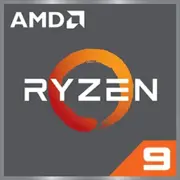AMD Ryzen 9 7900X

AMD Ryzen 9 7900X: Power for Professionals and Gamers in 2025
Updated: April 2025
1. Key Features: Zen 4, 5nm, and More
The AMD Ryzen 9 7900X processor, released in late 2022, remains relevant in 2025 thanks to its advanced Zen 4 architecture and TSMC 5nm FinFET manufacturing process. This 12-core (24 threads) chip has a base frequency of 4.7 GHz and can reach a maximum turbo frequency of up to 5.6 GHz.
Key Features:
- Cache Memory: 64 MB L3 — a record amount for gaming CPUs, enhancing the processing of complex tasks.
- Integrated Graphics: Radeon with 2 cores, supporting 4K displays. Suitable for emergencies (e.g., in case of discrete graphics card failure).
- Power Consumption: TDP of 170W, but can consume up to 230W under peak loads.
- Performance: In Geekbench 6 — 2908 (single-core) and 17718 (multi-core). For comparison, the Ryzen 9 5950X (Zen 3) scores around 2100/16000 in the same test.
Next-Gen Features:
- Support for PCIe 5.0 — doubled bandwidth for SSDs and graphics cards.
- Precision Boost Overdrive (PBO) and EXPO technologies for automatic overclocking and memory optimization.
2. Compatible Motherboards: AM5 and Chipset Choices
The processor uses the AM5 socket, which AMD promises to support until 2026. Current chipsets:
- X670E (Extreme): For enthusiasts. Examples: ASUS ROG Crosshair X670E Hero ($450–500). Supports overclocking, up to 24 PCIe 5.0 lanes, USB4.
- B650: Budget option with PCIe 5.0 only for the graphics card or SSD. For example, MSI MAG B650 Tomahawk ($220–250).
- A620: Minimalist. No overclocking, PCIe 5.0 only for GPU. Suitable for office PCs (Gigabyte A620M DS3H — $120).
Tip: Choose motherboards with a powerful VRM (such as 14+2 phases) and heatsinks — the 7900X is demanding in terms of power stability.
3. Memory: Only DDR5, with Nuances
The Ryzen 9 7900X works only with DDR5, which has become the standard in 2025. Recommendations:
- Optimal frequency: 6000 MHz (with EXPO) — higher may cause stability issues.
- Capacity: 32 GB for gaming, 64+ GB for work tasks (rendering, virtualization).
- Examples: Kingston Fury Renegade DDR5-6000 (32 GB — $150) or G.Skill Trident Z5 Neo (64 GB — $300).
Important: Memory with low timings (CL30–32) can provide a 5–7% performance boost in games.
4. Power Supply: Don’t Skimp on Watts
With a TDP of 170W and the appetite of a discrete graphics card (for example, RTX 4080 — 320W), the minimum power supply wattage should be 750W. Recommended:
- 850W with 80+ Gold certification (Corsair RM850x — $140).
- For high-end GPUs (RTX 4090) — 1000W (Seasonic PRIME GX-1000 — $220).
Common Mistake: Using cheap power supplies without surge protection. This poses a risk to system stability.
5. Pros and Cons: Who is the 7900X Perfect For?
Pros:
- Best price/performance ratio in the HEDT segment (around $450 in 2025).
- Support for PCIe 5.0 and DDR5.
- Integrated graphics — a lifesaver in cases of GPU issues.
Cons:
- High temperatures under load (up to 95°C).
- Requires an expensive motherboard and cooling solution.
- Competitors from Intel (i9-14900K) are faster in single-threaded tasks.
6. Use Cases: Gaming, Rendering, and More
- Gaming: The 7900X provides 120+ FPS in 4K (Cyberpunk 2077, Starfield) when paired with a powerful graphics card.
- Work Tasks: Rendering in Blender on 12 cores is 30% faster than with the Ryzen 7 7700X.
- Streaming and Editing: Encoding in OBS Studio without loss of FPS thanks to 24 threads.
Example: A video editor in DaVinci Resolve notes a 25% faster export time for 4K video compared to the Ryzen 9 5900X.
7. Comparison with Competitors: Intel and Others
- Intel Core i9-14900K (24 cores, 32 threads): Better in single-threaded tasks (Geekbench 6 Single-Core — 3100), but consumes up to 300W. Price: $550.
- Apple M3 Max (16 cores): More energy-efficient but limited to the macOS ecosystem. Not suitable for gaming.
- Ryzen 9 7950X: 16 cores for $600 — a choice for professionals, but excessive for most users.
Conclusion: The 7900X strikes a balance between price and power for PC platforms.
8. Practical Assembly Tips
- Cooling: Minimum — 280 mm AIO (Arctic Liquid Freezer II — $100). For overclocking — 360 mm (NZXT Kraken X73).
- Case: Good ventilation (Lian Li Lancool III). Avoid compact cases — the CPU heats up.
- SSD: Use PCIe 5.0 (for example, Crucial T700 — 12 GB/s) for maximum speed.
Mistakes:
- Installing a weak cooler (even top air coolers like the Noctua NH-D15 may struggle under peak loads).
- Saving on the motherboard — cheap B650 models may throttle performance.
9. Conclusion: Who is the Ryzen 9 7900X For?
This processor is suitable for:
- Gamers who want to play in 4K with future-proofing.
- Video editors, 3D designers, and streamers.
- Enthusiasts who value upgrade potential in AM5.
Alternatives:
- For savings: Ryzen 7 7800X3D ($350) — better for gaming, but weaker in multi-threading.
- For maximum performance: Ryzen 9 7950X3D ($700) — hybrid architecture with 3D V-Cache.
In 2025, the Ryzen 9 7900X remains relevant due to its reasonable price and versatility. It is the "golden mean" for those who don’t need extreme 16 cores but value stability and support for new technologies.
Basic
CPU Specifications
Memory Specifications
GPU Specifications
Miscellaneous
Benchmarks
Compared to Other CPU
Related CPU Comparisons
Share in social media
Or Link To Us
<a href="https://cputronic.com/en/cpu/amd-ryzen-9-7900x" target="_blank">AMD Ryzen 9 7900X</a>


